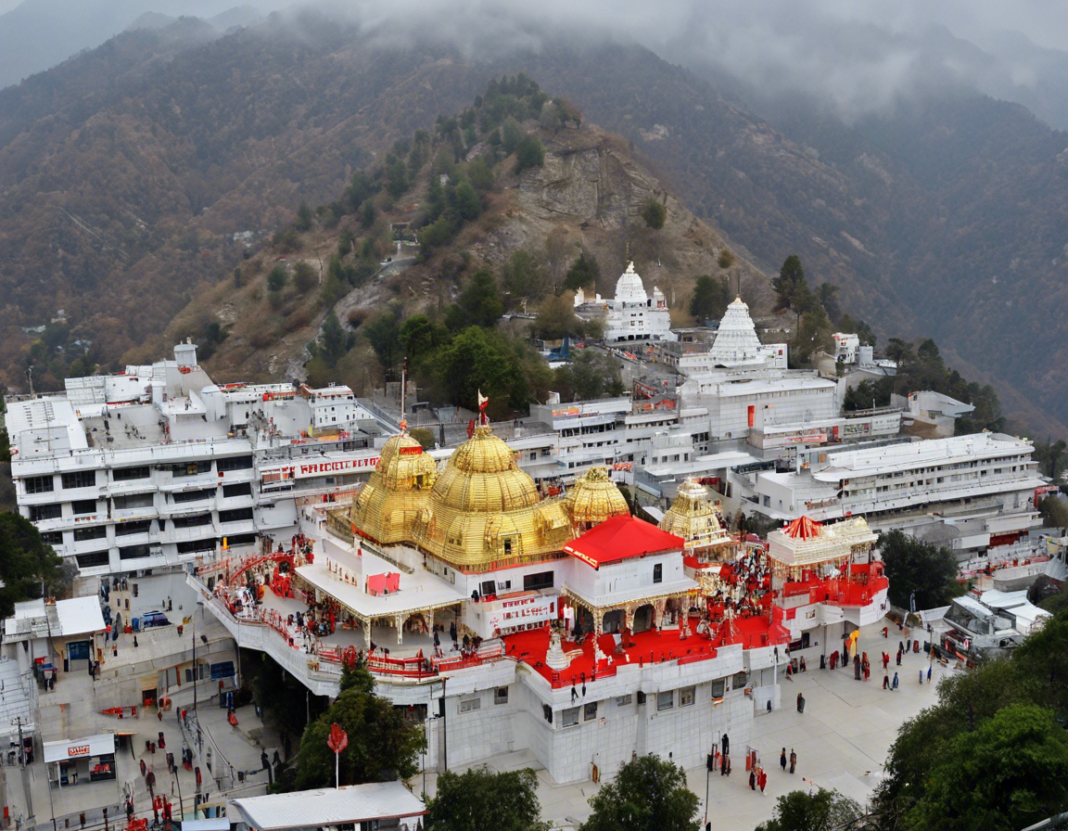Vaishno Devi Mandir: A Spiritual Journey Explained
The Vaishno Devi Mandir, located in the northern state of Jammu and Kashmir in India, is one of the most sacred and revered pilgrimage sites for Hindus. Nestled in the Trikuta Mountains at an altitude of 5,200 feet, this temple is dedicated to Goddess Vaishno Devi, also known as Mata Rani, who is believed to fulfill the wishes of her devotees. Millions of pilgrims undertake the arduous journey to seek her blessings and divine intervention in their lives.
History and Legend
The history of the Vaishno Devi Mandir dates back to ancient times and is shrouded in myths and legends. According to popular belief, Goddess Vaishno Devi was an incarnation of the Supreme Goddess Durga. The legend goes that she took refuge in the cave in the Trikuta Mountains to escape the pursuit of the demon Bhairon Nath. After a fierce battle, she finally defeated him, and it is said that his head fell at a place called Bhairon Ghati, which is also a part of the pilgrimage.
The Journey
For devotees, the journey to Vaishno Devi Mandir is not merely a physical one but a spiritual odyssey that tests their faith and determination. The pilgrimage starts at Katra, the base camp situated at the foothills of the Trikuta Mountains. From there, pilgrims have to trek approximately 12 kilometers to reach the holy cave temple.
The trek to Vaishno Devi Mandir is symbolic of the spiritual journey that one must undertake to attain the blessings of the Goddess. The path is arduous, with steep inclines and rocky terrain, requiring physical endurance and mental resilience. Along the way, pilgrims chant “Jai Mata Di” (Victory to the Mother Goddess) and seek her guidance and protection.
Significance of the Cave
The main sanctum sanctorum of Vaishno Devi Mandir is located inside a natural cave, which is divided into three chambers dedicated to the three forms of the Goddess – Mahakali, Mahalakshmi, and Mahasaraswati. The cave is adorned with stalactites and stalagmites, creating a mystical and ethereal atmosphere.
Devotees believe that a visit to the holy cave and darshan of the Goddess can fulfill their wishes and grant them salvation. The serene and tranquil ambiance of the cave temple provides a perfect setting for meditation and introspection, allowing pilgrims to connect with their inner selves and seek spiritual enlightenment.
Customs and Rituals
Before embarking on the pilgrimage to Vaishno Devi Mandir, devotees usually observe certain customs and rituals to purify their minds and bodies. Many pilgrims observe a period of fasting and abstinence in the days leading up to the journey. It is common to wear traditional attire and carry offerings like coconut, fruits, and flowers to present to the Goddess.
Once inside the cave temple, devotees offer prayers and seek the blessings of Goddess Vaishno Devi. The sound of the conch shell and the ringing of bells reverberate in the cave, creating a divine atmosphere filled with devotion and piety.
Accommodation and Facilities
To accommodate the large influx of pilgrims, the Shrine Board of Vaishno Devi provides various facilities in Katra and along the trekking route. There are accommodation options ranging from budget guesthouses to luxury hotels for pilgrims to rest and rejuvenate before and after their journey.
Additionally, facilities such as cloakrooms, medical aid centers, and food stalls are available along the trekking path to ensure the comfort and safety of pilgrims. Helicopter services are also available for those who are unable to undertake the trek on foot.
Frequently Asked Questions (FAQs)
1. What is the best time to visit Vaishno Devi Mandir?
The pilgrimage to Vaishno Devi Mandir can be undertaken throughout the year, but the months of March to October are considered the best time to visit due to favorable weather conditions.
2. How long does it take to complete the trek to Vaishno Devi Mandir?
The average time taken to complete the trek from Katra to the holy cave temple is around 6-8 hours, depending on the individual’s pace and physical fitness.
3. Is it safe to undertake the trek to Vaishno Devi Mandir alone?
While it is generally safe to trek alone, it is advisable to travel in groups or with a guide, especially for first-time visitors, as the path can be challenging and unfamiliar.
4. Are there facilities for senior citizens and persons with disabilities at Vaishno Devi Mandir?
The Shrine Board provides facilities such as palanquins and ponies to assist senior citizens and persons with disabilities in completing the trek. Special arrangements can also be made for their comfort.
5. Can I carry electronic devices and cameras inside the cave temple?
Electronic devices such as mobile phones and cameras are not allowed inside the sanctum sanctorum of the cave temple as a mark of respect to the Goddess. Visitors are required to deposit them at designated counters before entering.
6. Is photography allowed along the trekking route to Vaishno Devi Mandir?
Photography is allowed along the trekking path, but it is advisable to capture the scenic beauty and moments of the pilgrimage respectfully without causing inconvenience to fellow pilgrims.
7. Are there food and water facilities available along the trekking route?
Yes, there are several food stalls and water points strategically located along the trekking path to cater to the needs of pilgrims. It is recommended to carry snacks and water bottles for the journey.
8. Can I book helicopter tickets in advance for Vaishno Devi Mandir?
Helicopter tickets for Vaishno Devi Mandir can be booked online in advance through the official website of the Shrine Board or at the designated counters in Katra. It is advisable to book early during peak pilgrimage seasons.
9. What are the precautions to be taken during the pilgrimage to Vaishno Devi Mandir?
Pilgrims should ensure they are in good physical health before undertaking the trek and carry necessary essentials like comfortable footwear, clothing, and first-aid kits. It is also advisable to check weather conditions and plan the journey accordingly.
10. Can non-Hindus visit Vaishno Devi Mandir?
Yes, Vaishno Devi Mandir is open to people of all faiths and backgrounds. The pilgrimage is a spiritual journey that welcomes devotees seeking the blessings of Goddess Vaishno Devi, irrespective of their religious affiliations.
In conclusion, a visit to Vaishno Devi Mandir is not just a physical expedition but a profound spiritual experience that deepens one’s faith and devotion. The arduous journey, the mystical cave temple, and the serene surroundings all contribute to the sanctity and significance of this sacred pilgrimage site. For millions of devotees, a pilgrimage to Vaishno Devi Mandir is a transformative journey that connects them to the divine and reaffirms their faith in the ultimate power of the Goddess.









